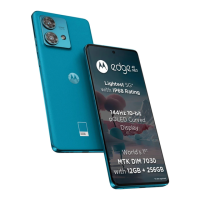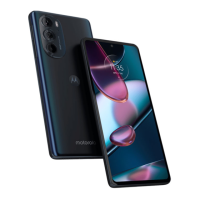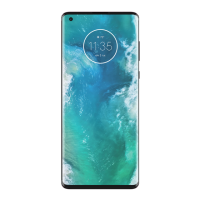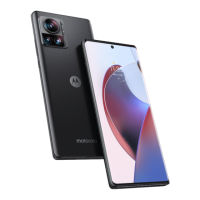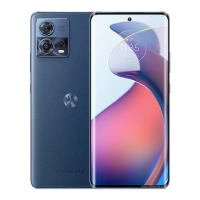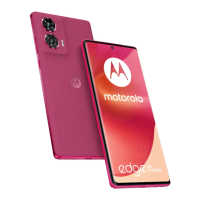Do you have a question about the Motorola edge 40 and is the answer not in the manual?
Explains the physical components and their functions on the phone.
Instructions for managing the physical SIM card and eSIM.
Steps to transfer data from iPhone and Android devices to your new phone.
Information on configuring and using two SIM cards simultaneously.
Details the layout and elements of the phone's home screen.
Explains how to interact with and customize the lock screen.
Provides a guide to understanding the icons in the status bar.
Guide to using touch, drag, swipe, and pinch gestures for navigation.
How to access and adjust frequently used settings from the quick settings panel.
Instructions for manually turning the phone's screen on and off.
Methods for capturing still images of the phone's screen.
Steps to record video of the phone's screen activity.
Using Google Assistant for commands, navigation, and information retrieval.
How to use voice commands or widgets to get navigation assistance.
Covers opening, closing, resizing, and typing on the virtual keyboard.
Instructions for selecting and manipulating text from various sources.
Changing wallpaper, widgets, shortcuts, and app arrangement on the home screen.
Setting up screen savers and adding messages to the lock screen.
Downloading apps from the Play Store and managing app updates.
Organizing, uninstalling, and controlling permissions for installed applications.
Sending, receiving, and managing SMS and MMS messages.
Reading, sending, and managing emails across different accounts.
Making, receiving, and managing phone calls, including call waiting and blocking.
Managing Wi-Fi, Bluetooth, Airplane mode, data usage, and connections.
Configuring screen locks, fingerprint sensor, app permissions, and privacy settings.
Customizing keyboard settings, language, and input methods.
Troubleshooting phone performance, power, screen, and restart problems.
Resolving problems with calls, signal strength, and SIM card recognition.
Troubleshooting charging problems and battery drain.
Fixing problems with apps not working, crashing, or disappearing.
Steps for updating software, resetting network settings, and performing factory resets.
Explains the physical components and their functions on the phone.
Instructions for managing the physical SIM card and eSIM.
Steps to transfer data from iPhone and Android devices to your new phone.
Information on configuring and using two SIM cards simultaneously.
Details the layout and elements of the phone's home screen.
Explains how to interact with and customize the lock screen.
Provides a guide to understanding the icons in the status bar.
Guide to using touch, drag, swipe, and pinch gestures for navigation.
How to access and adjust frequently used settings from the quick settings panel.
Instructions for manually turning the phone's screen on and off.
Methods for capturing still images of the phone's screen.
Steps to record video of the phone's screen activity.
Using Google Assistant for commands, navigation, and information retrieval.
How to use voice commands or widgets to get navigation assistance.
Covers opening, closing, resizing, and typing on the virtual keyboard.
Instructions for selecting and manipulating text from various sources.
Changing wallpaper, widgets, shortcuts, and app arrangement on the home screen.
Setting up screen savers and adding messages to the lock screen.
Downloading apps from the Play Store and managing app updates.
Organizing, uninstalling, and controlling permissions for installed applications.
Sending, receiving, and managing SMS and MMS messages.
Reading, sending, and managing emails across different accounts.
Making, receiving, and managing phone calls, including call waiting and blocking.
Managing Wi-Fi, Bluetooth, Airplane mode, data usage, and connections.
Configuring screen locks, fingerprint sensor, app permissions, and privacy settings.
Customizing keyboard settings, language, and input methods.
Troubleshooting phone performance, power, screen, and restart problems.
Resolving problems with calls, signal strength, and SIM card recognition.
Troubleshooting charging problems and battery drain.
Fixing problems with apps not working, crashing, or disappearing.
Steps for updating software, resetting network settings, and performing factory resets.
| Panel type | P-OLED |
|---|---|
| Screen shape | Flat |
| Pixel density | 402 ppi |
| Display diagonal | 6.55 \ |
| Touchscreen type | Resistive |
| Display brightness | 1200 cd/m² |
| Display resolution | 2400 x 1080 pixels |
| Native aspect ratio | 20:9 |
| High Dynamic Range (HDR) supported | Yes |
| High Dynamic Range (HDR) technology | High Dynamic Range 10+ (HDR10 Plus) |
| Multimedia Messaging Service (MMS) | Multimedia Messaging Service (MMS) is a standard way to send messages that include multimedia content to and from a mobile phone over a cellular network |
| Color name | Viva Magenta |
| Form factor | Bar |
| Product color | Magenta |
| Housing material | Aluminum |
| International Protection (IP) code | IP68 |
| Processor model | 8020 |
| Processor family | MediaTek Dimensity |
| Processor frequency | - GHz |
| RAM type | LPDDR4X |
| RAM capacity | 8 GB |
| Compatible memory cards | Not supported |
| Internal storage capacity | 256 GB |
| Speakers | stereo |
| Audio system | Dolby Atmos |
| Rear camera type | Dual camera |
| Front camera type | Single camera |
| Maximum frame rate | 240 fps |
| Image stabilizer type | Optical Image Stabilization (OIS) |
| Video recording modes | 1080p, 2160p |
| Rear camera pixel size | 1 µm |
| Front camera pixel size | 0.7 µm |
| Rear camera sensor size | 1/1.5 \ |
| Rear camera aperture number | 1.4 |
| Resolution at capture speed | 1920x1080@30fps, 3840x2160@30fps |
| Front camera aperture number | 2.4 |
| Second rear camera pixel size | 1.12 µm |
| Rear camera resolution (numeric) | 50 MP |
| Front camera resolution (numeric) | 32 MP |
| Second rear camera aperture number | 2.2 |
| Second rear camera resolution (numeric) | 13 MP |
| Second rear camera field of view (FOV) angle | 120 ° |
| Platform | Android |
| Virtual assistant | Google Assistant |
| App distribution platform | Google Play |
| Operating system installed | Android 13 |
| Battery capacity | 4400 mAh |
| Cables included | USB Type-C to USB Type-C |
| AC adapter power | 68 W |
| 3G standards | - |
| SIM card type | NanoSIM + eSIM |
| Wi-Fi standards | 802.11a, 802.11b, 802.11g, Wi-Fi 4 (802.11n), Wi-Fi 5 (802.11ac), Wi-Fi 6 (802.11ax) |
| Bluetooth version | 5.2 |
| 3G bands supported | 800, 850, 1700, 1900, 2100 MHz |
| 4G bands supported | 600, 700, 800, 850, 900, 1900, 2000, 2100, 2300, 2400, 2500 MHz |
| 5G bands supported | 600, 700, 800, 850, 900, 1500, 2000, 2100, 2300, 2400 MHz |
| SIM card capability | Dual SIM |
| Mobile network generation | 5G |
| Subscription type | No subscription |
| USB connector type | USB Type-C |
| Repairability index | 7.9 |
| Depth | 7.58 mm |
|---|---|
| Width | 71.99 mm |
| Height | 158.43 mm |
| Weight | 171 g |

